To win in the marketplace you must first win in the workplace.
—Doug Conant, American businessman and former CEO, Campbell Soup Company
Agile HR with SAFe
Bringing People Operations into the 21st Century with Lean-Agile Values and Principles
by Fabiola Eyholzer, CEO, Just Leading Solutions LLC with Dean Leffingwell, Co-founder and Chief Methodologist, Scaled Agile, Inc.
[scd_58679 title=”community-contributions”]Introduction
The digital transformation is affecting virtually every enterprise across the globe. Competing requires a level of competence and ability in the development and deployment of software and systems unlike that which brought the successful Enterprise to this point. Such new competencies can no longer be mastered through industrial age structures and practice.
Responsive enterprises act by a) acknowledging talent, knowledge, and leadership as the new currency for competitiveness and by b) embracing Lean-Agile values, principles, and practices.
The Scaled Agile Framework ® (SAFe) has emerged as the leading framework for addressing this challenge at enterprise scale. In addition to extensive practice guidance, SAFe promotes and describes a comprehensive set of values and principles that Lean-Agile Mindset leaders can use to foster the transformation and continue the journey to enhanced competitiveness in software and systems building. Figure 1 characterizes the SAFe approach.
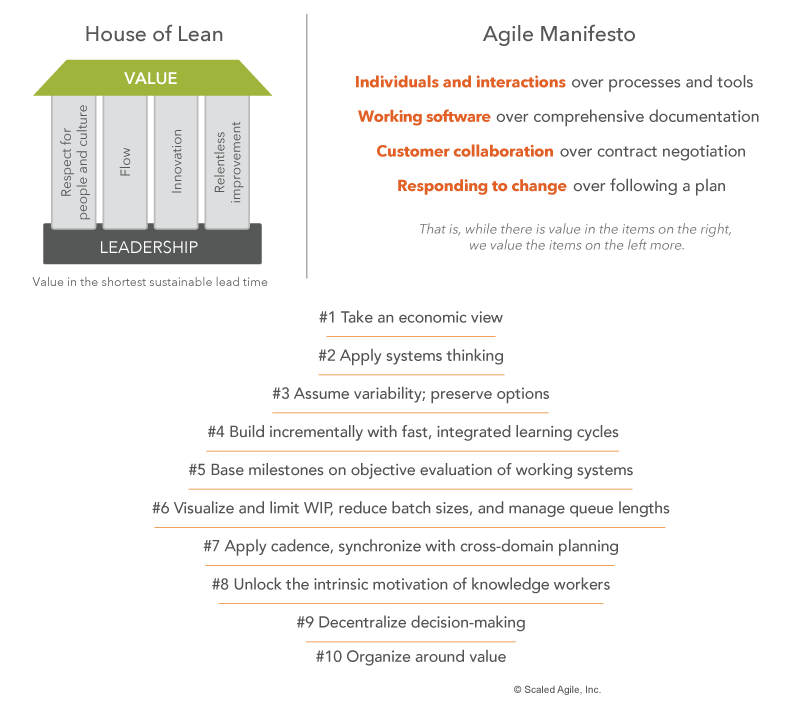
This new mindset challenges Human Resources (HR) to realign their people approach with this new way of working. It imposes a far-reaching transformation to bring HR into the 21st Century by shifting from a process-oriented HR Management to an empowering Lean-Agile people operations. It changes the face and significance of HR forever.
In this whitepaper, we will describe six basic themes that can guide Leaders and their HR Partners on how to address various aspects of more contemporary Lean-Agile people solutions in the Lean-Agile enterprise. These are:
#1 – Embrace the New Talent Contract
#2 – Foster Continuous Engagement
#3 – Hire for Attitude and Cultural Fit
#4 – Move to Iterative Performance Flow
#5 – Take the Issue of Money off the Table
#6 – Support Impactful Learning & Growth
#1 – Embrace the New Talent Contract
Today is the age of digital disruption and enterprises must respond to the new realities by fundamentally reinventing their mindsets, behavior, leadership, and ways of working. The driving force behind the Lean-Agile organizations is knowledge workers – the fastest growing and most critical workforce sector. Drucker defines knowledge workers “as people who know more about the work they perform than their bosses.” Their jobs consist of converting information into knowledge and instantiating that knowledge in systems and solutions. It is their ideas, experiences, and interpretations that keep businesses moving forward. The results of their intermediate work are often intangible and require improvisation; the use of judgment in ambiguous situations, as well as interactions with others, is continuously required. As such, it defies traditional, task-based management.
Knowledge workers thrive on this kind of challenging work. It motivates their very being. But they also seek meaning and purpose in their careers; and appreciation and respect. They want to take responsibility and be actively involved. In order to innovate and contribute, they must be allowed to manage themselves with significant autonomy and empowerment.
This forms the basis for creating and honoring the new talent contract. It is not only about understanding the drive of knowledge workers, but also recognizing the power shift that comes with it. In SAFe, this goes hand in hand with a move from task-management and command & control to inspiring leadership.
It is well elaborated in two of the SAFe Lean-Agile Principles, specifically:
Principle # 8 – Unlock the intrinsic motivation of knowledge workers
Principle # 9 – Decentralize Decision-Making
This, inevitably, also affects the way HR interacts and engages with both management and the workforce. Employees will claim a voice in shaping the way their organization takes care of them – not only when it comes to their career development, but across the whole HR value chain.
Like management practices, people operations must become less prescriptive and more flexible, empowering and accommodating. HR solutions become co-created and evolve constantly. This is an integral part of building places of work full of inspiration and engagement.
#2 Foster Continuous Engagement
Tapping into the intrinsic motivation of people — keeping them deeply engaged in the enterprise’s purpose — has never been more important. Enterprises with engaged employees have much higher returns. Yet the vast majority of employees worldwide are dissatisfied, disillusioned, and disengaged.
Agile understands the power of bringing intrinsically motivated people together to form collaborative empowered teams. In addition, SAFe then puts them onto an Agile Release Train (ART) where they are engaged with others on a common mission, and collaborate via face to face planning. Anyone who has ever participated in one of their Program Increment (PI) Planning has firsthand experience of the enthusiasm and energy in the room. Unsurprisingly, SAFe teams are more passionate and involved.
Simply, engagement–perhaps sometimes dismissed as idealistic HR notion, translates directly into better business performance and success. Figure 2 illustrates the realities of disengagement and the benefits of high employee engagement.[1]

Engagement fosters retention. The best way to lower turnover is to invest in people. The concept of improving the market value of employees and making them more attractive for competitors may seem counterintuitive. But actively developing people takes away their need to switch jobs in order to improve and advance.
Agile practices allow people to evolve through challenging work, powerful collaboration, constant reflections, continuous feedback, and relentless improvement – all deeply embedded into the workflow. In other words, Agile does not distinguish between learning and working: Working equals learning, And knowledge workers are learning workers.
Hence, the goal of Agile Enterprises is not simply to retain talents, but to let them grow and thrive; and develop a flourishing talent pool.
#3 Hire for Attitude and Cultural Fit
Building a vigorous workforce starts with identifying, attracting, and hiring the right people. But finding top talent is increasingly difficult. When it comes to Talent Acquisition, Agile Enterprises get a competitive edge by considering the following:
Build a strong employer brand – Agile is a magnet for talented people. Enterprises can – and should – build on their commitment to Agile excellence and use it to help build a strong employer brand.
Proactively attract and engage knowledge worker talent – It’s a competitive market for top digital talent. Recruitment starts long before a new vacancy comes up. The talent acquisition team must continuously reach out and connect with interesting technical people to pull them into the talent pipeline.
Employ for attitude and cultural fit – Agile is a team sport. Technical expertise is important, but Agile teams prosper when hiring candidates with the right attitude and cultural fit. The tendency for heroism and over specialization must be avoided. After all, success depends on the collective and collaborative skills of the team. Figure 3 shows some interview questions that can be used to address candidates’ ability to thrive in a team setting[2].
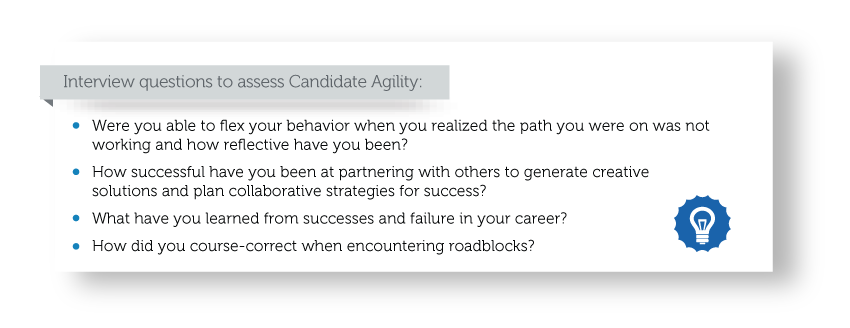
Inspire candidates with a larger sense of purpose – Knowledge workers need a sense of purpose in their lives. Something beyond the bits and bytes, and even beyond their local team environment is required. Helping candidates understand the larger purpose of the organization is the best way to inspire them. Strengthen this by being genuine and dependable throughout the whole process.
Make a solid, team-based decision – Talent acquisition is a shared responsibility, and no hiring decision should be made without the backing of the team. After all, no employee can thrive without team support. Therefore, the team must be actively included in the hiring process.
Excel at onboarding – Agile has fairly well-defined team practices and roles and is unbeatable in getting new people up to speed once on board. Prior to that, however, pre-integration activities, interactions, and access to information can enhance the onboarding experience. Post onboarding support requires communication and touch points with the individual, to assure that they are happy in the role, and that management is content with their performance.
A high-quality recruitment process reduces the risk of bad hires and subsequent disruptions to the flow and performance of the team(s).
#4 Move to Iterative Performance Flow
Undeniably: Performance management is the most criticized HR process today. But despite a long list of complaints, many organizations still invest top dollars into a broken performance appraisal practice. The fact is, traditional performance appraisals simply don’t work.
While Performance Management was initially installed to align goals and foster joint efforts –it has since evolved into this the pivotal point for an entire set of HR practices, especially Compensation and Talent Management.
No wonder, annual performance reviews have turned into a tense time for everyone involved. Managers tend to batch feedback, both negative and positive, into the annual feedback dump, depriving employees of the timely feedback they need to actually improve when it matters; and employees are nervous about their appraisal as it affects their upcoming compensation and promotional chances.
Review tools are in place to help guide the discussion and ‘force’ managers to rank their people. This means many companies excel at calculating ratings. But it comes at a high cost to the morale and motivation of people. However, the tides are shifting, and organizations of all shapes and sizes are already eliminating employee appraisals in order to respond to the challenges and interfaces to HR instruments. Figure 4 demonstrates the facts and trend of traditional performance management systems [3].
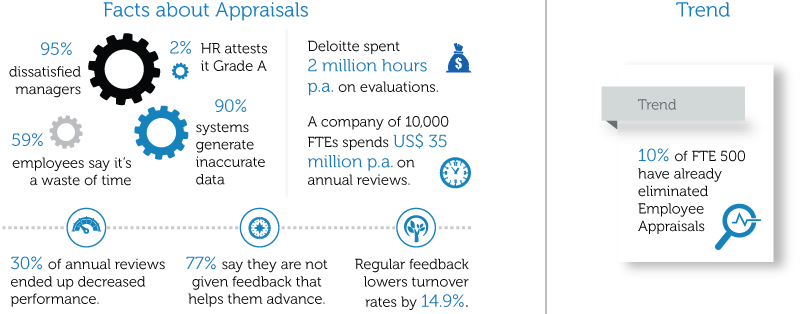
This challenges HR to push the reset button on performance management on all levels. Here is how SAFe can help re-optimize the system for performance flow:
Align performance cycle in iterations -The accelerated pace of today’s business world makes it increasingly difficult to think in multi-year periods and set rigid top-down annual goals. SAFe shifts from 12-month cycles to an iterative, interactive process measured in weeks and PI Plannings. These iterations reflect an optimal cadence and represent the new performance cycles.
Utilize PI planning to share the vision, set inspiring goals, and clarify expectations – Being able to inspire people is imperative. The heartbeat of the ART is the PI Planning. All members of the train come together to understand the business context and vision, set and synchronize goals, clarify expectations and dependencies, and commit to common objectives. This replaces static individual goals with verifiable collaborative objectives.
Continuously inspect and adapt – Agile ceremonies like Iteration Reviews and Iteration Retrospectives are all about inspecting and adapting. While iterations focus on the system under development, not the people, they do provide formal and informal opportunities in team retrospectives (each iteration) and Inspect and Adapt (program retrospectives) to provide feedback on individual and team performance. The focus is, hence, no longer on assessing individual goals, but on continuous improvement – not only on a personal but also on a program enterprise level (something neglected in traditional performance appraisals).
Embed learning and development into the workflow – Companies must constantly evolve, and Agile ways of working are all about learning. SAFe enhances it with the Innovation & Planning (IP) Iteration as an integral part of the PI. This gives people the time and space to improve and innovate at their own pace. Cross-role, cross-functional, and cross-team training further enhance the skills, flexibility, and utility of the knowledge worker. These mechanisms support the particular need of the knowledge worker and help the enterprise fulfill its responsibility to create a workflow that allows for active learning and growth.
Eliminate annual performance ratings in favor of continuous feedback – Instead of employee ratings, Agile organizations shape a culture of mutual respect where candid dialogues and continuous feedback consistently take place between leaders, employees, and peers. This focus on relentless improvement is a key part in embracing agility and achieving its full impact. It also fundamentally increases the intensity and quality of discussions on personal accomplishments and growth potentials.
These new ways of working fulfill the original goals of performance management far better than any annual performance rating. And by bringing a Lean-Agile mindset to all HR practices, people operations continuously engages, interacts, grows and recognizes talents – without the need for an employee appraisal to act as a trigger. Thus, making annual ratings and forced rankings obsolete in an agile world. Performance flow in Agile enterprises is all about optimal cadence, responsiveness, and growth – not about monetary incentives.
#5 Take the Issue of Money off the Table
The industrial era belief that money is the strongest (and only effective) motivator for employees is firmly rooted in many organizations. Unsurprisingly, compensation and cash bonuses are still used as a predominant way to incentivize and recognize people – an expensive and ineffective approach for knowledge workers.
Ever since Daniel Pink’s “Drive” (and decades of scientific studies), it is clear: Agile people are driven by mastery, autonomy, and purpose. Meaningful reward and recognition for them come in forms of pride in achievement, social contacts, interesting work, new challenges, growth opportunities, and self-fulfillment.
The way to take the topic of money off the table is by paying employees fairly and competitively, but also by having open and honest communication about pay, and by making matching compensation with adequate reward and recognition.
Here are some guidelines to help rethink reward solutions:
Base Salary
Pay adequate base salaries – Roles in agile teams are based on generic value descriptions rather than specific individual job descriptions. Any job is consequently less stringent and instead, requires a high degree of flexibility and ability to activate and apply relevant knowledge. Adequate base salaries, therefore, compensate not only the role but the person’s skills and experiences. Once a knowledge worker accepts that they are fairly (and competitively) compensated, they are free to focus on the work, not the money.
Decentralize salary decisions – Compensation has to be easy to deliver – and change. This means empowering managers to set salaries and pay increases. These adjustments must be decoupled from an annual process. This allows for a more flexible schedule and helps separate the concern of compensation from performance feedback. Leaders are guided in their decision by peer reviews, transparency, as well as adequate data and expert advice, provided by a dedicated Reward Solution team as requested.
Bring transparency to the salary structure – A transparent salary structure brings many advantages like fostering greater trust and honoring the value of employees, independent of their personal negotiation skills. (Indeed, many valuable knowledge workers are poor salary negotiators. In its place, they must feel that they are not disadvantaged by those who lobby more vociferously for money.) However, any company needs to evaluate (and test) carefully what degree of transparency is feasible in their environment.
Incentives
Avoid toxic individual bonuses – Management-by-Objectives (MBO)-based individual, and team bonuses are toxic for an organization that thrives on collaboration and responsiveness. They set individual against individual and team against team. They should be eliminated entirely. However, fair, transparent incentives that honor collective performance and corporate success (for example, equity and profit sharing plans), allow employees to participate financially in the success of the enterprise and thereby feel they are fairly and justly treated for enterprise success. But avoid incentives that might provide an undesired motivation for people to stay or interfere with the company’s need to move an employee out quickly.
Combine various forms of recognition – Impactful appreciation must be aligned with corporate values. Each enterprise must find a suitable combination of low frequency formal, recognition with more frequent and intimate, personal acknowledgments. Once set, the power of recognition is put into everyone’s hand. Figure 5 represents an example of a diversified recognition program [4].
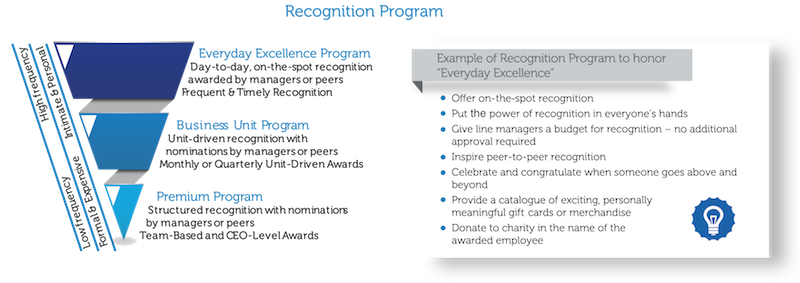
Benefits
Provide benefits that people value – Benefits are more than pension plans and healthcare: they are about making the lives of people easier and better. Flexible schedules, remote office, parental leave, financial guidance, time off, and volunteer opportunities are examples of tangible benefits that help people find their optimal, work-life balance.
Invest in the health and well-being of people – Companies face unnecessary ‘waste’ in the form of stress, anxiety, burnouts, and chronic health issues. Investments in the well-being of employees are not only the right thing to do but translate directly into revenue. A balanced reward approach is a part of “taking the topic of money off the table.” It promotes a broader understanding of an effective incentive system – one that appreciates the appeal of growth opportunities.
#6 Support Impactful Learning & Growth
Learning and growth have always been intertwined. But it takes on a completely new dynamic in a world of accelerating change, wherever shorter half-life of facts and knowledge is a reality.
Here are some points to guide the journey:
Create a learning organization – While working is a key part of learning, agile people must also understand how knowledge grows, changes, and is overturned; and be given a method to acquire relevant new skills and competencies as well as the ability for transfer of learning. That is why a learning organization offers contemporary learning and teaching methods; captures and distributes intellectual capital, and provides transparency and access to knowledge and skills.
Empower employees to take the lead – In line with new talent contract, employees are not only empowered when it comes to their work, but they are also in charge of their own development. They access knowledge, attend learning sessions, build a network, and shape their progress and career path according to their own needs and perceptions. This journey is strongly guided – but not driven or controlled – by people operations and Lean-Agile Leaders.
Illustrate prospective role-based career paths – Modern careers are more about personal choices and meaningful growth than climbing a (fast disappearing) hierarchical ladder. Consequently, career paths are becoming more fluid, multifaceted, and individualized than ever before. A catalog of prospective role-based career paths can illustrate typical growth paths, but without limiting the options to a pre-set career model. Figure 6 presents an example of such a role-based career path [5].
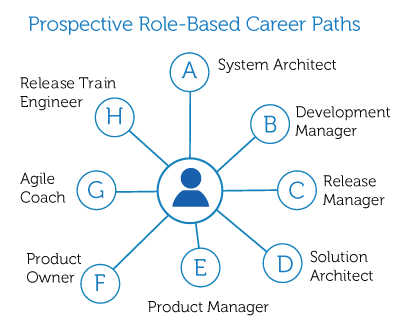
Establish individual career coaching – A dedicated team of career coaches can connect with each person individually in order to outline an individual career profile with a learning and growth plan, that is continuously reviewed and adjusted as needed. This ensures that boosting the (internal) market value of people is always in focus, but it also equips the organization with a previously untapped understanding of their talent pipeline. HR no longer depends on a rating from an annual appraisal, because they know their people on a personal, authentic level.
Apply Agile workforce planning and talent scouting – Allowing for flexible careers requires agile workforce planning and talent scouting. People operations must understand the organization and its changing needs and be able to match that with the circumstances and aspirations of people positively.
Enhance development through Lean-Agile Leaders – Lean-Agile Leaders are lifelong learners, teachers, and people developers. They engage in continuous listening, communication, and feedback in order to identify development areas and boost learning. These constant interactions are crucial to the success of both: individuals and teams. The best leaders not only develop people but let them spread their wings – even if it means letting them take on a new challenge in a different role/place within the organization. While it opens up an attractive world of growth opportunities, it also boosts skill sharing and knowledge transfer across the enterprise.
It is the aligned and combined effort of employees, leaders, and HR that enables the organization to become a learning network with an unbeatable talent pool – the foundation of a resilient Lean-Agile Enterprise.
Summary
The face of organizations is changing fast – and drastically. Lean-Agile development with SAFe reinvents the way we work and helps us build an engaged, talented, and vigorous workforce. It a valuable stepping stone to guide your HR into the 21st Century. But no matter where you are in your transformation journey towards a modern responsive Enterprise, the time is right to embrace Lean-Agile People Operations and become equipped to deal with the challenges of today’s organizations and people.
So, Agile Professionals: Reach out to your HR organization and invite them to SAFe training, ceremonies, and learning sessions; and support them in bringing a Lean-Agile mindset to their People approach.
Likewise, HR Professionals: connect with Agile teams and experience firsthand the power of Agile; and become educated and knowledgeable about Lean-Agile values, principles, and practices.
Investing in Lean-Agile people operations is an investment in your people and your future.
Learn More
[1] Sources: Gallup via Employee Engagement & Loyalty Statistics 2014 by B. Carter, Office Vibe “13 Disturbing Facts About Employee Engagement,” November-2014, American Management Association (AMA) Database 2015 – Torben Rick, Infographic 2014, Employee Engagement 2014, Daily Infographic, Scaled Agile Case Study Meets Big Iron at John Deere [2] Just Leading Solutions, 2016. [3] Sources: Corporate Executive Board 2014 | SHRM Survey: HR Professionals’’ Perceptions about PM effectiveness (Oct-21-2014) | Harvard Business Review April 2015: Reinventing Performance Management by Marcus Buckingham & Ashley Goodall | The Washington Post Jul-21-2015: In big move, Accenture will get rid of annual performance reviews and rankings by Lillian Cunningham | Co.Tribute: A Performance Review That Actually Means Something by Carson Leith, Mar-2016 | Harvard Business Review, June, 2012; Talent Management, May 2012 Image, Discovery Education | Infographic “11 Eye-Opening Statistics on the Importance of Employee Feedback”, Officevibe 2015 – Why Employee Performance Reviews Are So Old School, Millie Dent, The Fiscal Times, Jul-2015. [4] Adapted from Nokia New Recognition Framework, HR Tech World Congress, 2015. [5] Just Leading Solutions, 2016Last Update: 3 January 2022


